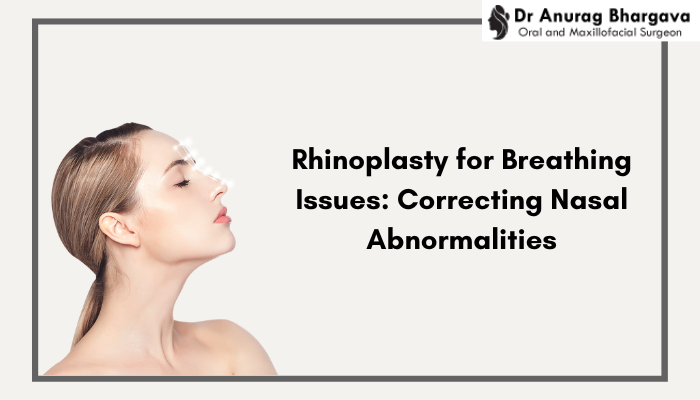Breathing is an essential part of our daily existence, but for some, it becomes a constant struggle. Often, the culprits behind compromised breathing are a deviated septum or nasal obstruction. While these issues are commonly associated with cosmetic concerns, this blog aims to shed light on how rhinoplasty, beyond its cosmetic benefits, serves as a powerful corrective tool for those grappling with functional breathing challenges.
Understanding the Culprits
Deviated Septum
The septum, a seemingly insignificant part of our nasal anatomy, plays a crucial role in airflow. When it deviates, a domino effect occurs, leading to breathing difficulties. Whether caused by a past injury or inherited, a deviated septum can significantly impact one's ability to breathe freely.
Nasal Obstruction
Beyond the septum, various factors contribute to nasal obstruction. Swollen turbinates or nasal polyps can further impede airflow, compounding the challenges associated with a deviated septum. Understanding these intricacies is pivotal in seeking the right solutions.
Signs and Symptoms
Identifying a deviated septum and nasal obstruction requires a keen awareness of the associated signs and symptoms. Persistent nasal congestion, difficulty breathing through one or both nostrils and recurring sinus infections are red flags that should prompt further investigation. Recognizing these symptoms is the first step toward regaining control over your breathing.
Diagnosis
Diagnosing these structural issues involves a comprehensive examination by an Ear, Nose, and Throat (ENT specialist). Physical assessments, nasal endoscopy, and imaging tests like CT scans are crucial tools in pinpointing the root causes of breathing difficulties. A precise diagnosis lays the foundation for an effective treatment plan.
Non-Surgical Options
In cases where breathing difficulties are less severe, non-surgical interventions stand as initial steps towards relief. These non-invasive approaches, such as nasal sprays and medications, aim to alleviate symptoms and improve airflow. Let's explore this avenue before considering the imperative need for surgical correction in scenarios where structural abnormalities take center stage.
1. Nasal Sprays
Decongestant Nasal Sprays: These work by narrowing blood vessels, reducing inflammation, and easing congestion temporarily.
Steroid Nasal Sprays: Ideal for addressing inflammation, they help reduce swelling and improve nasal airflow.
2. Medications
Antihistamines: Effective for allergic reactions causing nasal congestion.
Leukotriene Modifiers: Targeting inflammation, these can help manage symptoms related to nasal obstruction.
While these options provide initial relief, their effectiveness is often limited when structural abnormalities play a significant role in breathing difficulties. For individuals grappling with a deviated septum, enlarged turbinates, or other structural issues, the need for more profound intervention becomes apparent.
Surgical Correction: When Necessity Arises
The surgical journey begins with carefully planned incisions, allowing the surgeon access to the nasal structures. Whether addressing a deviated septum, reducing turbinates, or removing nasal polyps, the surgical procedure is a meticulous process. This section will walk you through techniques that preserve or enhance the nose's aesthetic appeal while rectifying functional concerns.
1. Structural Abnormalities Persist
If symptoms persist despite non-surgical attempts, it indicates that underlying structural issues may require a more targeted approach.
2. Deviated Septum Hindering Airflow
In cases where the septum deviates significantly, causing persistent nasal obstruction, surgical correction becomes a viable solution.
3. Turbinate Reduction:
Enlarged turbinates, contributing to nasal blockages, might need surgical reduction to restore optimal airflow.
4. Nasal Polyps
Surgical removal may be necessary for nasal polyps obstructing the nasal passages.
5. Chronic Sinus Issues
When chronic sinus problems exacerbate breathing difficulties, surgical procedures like functional endoscopic sinus surgery (FESS) may be recommended.
6. Endoscopic Procedures
Utilizing advanced endoscopic techniques, surgeons can precisely address structural abnormalities, ensuring a tailored and effective solution.
The Role of Rhinoplasty
Rhinoplasty, often associated with cosmetic enhancements, plays a transformative role in addressing functional issues. Beyond sculpting the nose for aesthetic appeal, skilled surgeons use rhinoplasty to correct the structural anomalies contributing to breathing problems. Whether it's reshaping the septum, reducing turbinate size, or addressing other obstructions, rhinoplasty becomes a beacon of hope for those seeking relief from compromised breathing.
Benefits and Expectations
The benefits of rhinoplasty for breathing problems extend far beyond aesthetic enhancements. Individuals undergoing this procedure can anticipate improved airflow, reduced nasal congestion, and an overall enhancement of breathing function. Setting realistic expectations is crucial, emphasizing that rhinoplasty primarily aims at functional improvements while considering the aesthetic harmony of the nose.
Consultation and Decision-Making
Seeking consultation with a qualified surgeon is a crucial step in the rhinoplasty journey. Several factors to consider during consultations, including the surgeon's expertise, personalized health considerations, and effective communication to ensure a collaborative decision-making process.
Summarising
This blog has navigated the landscape of rhinoplasty as a solution for breathing problems caused by a deviated septum and nasal obstruction. Emphasizing the transformative power of rhinoplasty beyond aesthetics, we encourage those facing these challenges to explore the possibilities this procedure offers in reclaiming the joy of unimpeded breathing.

